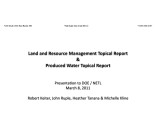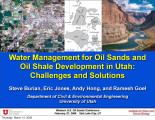TO
Filters: Collection: "ir_eua"
| Title | Date | Subject | Description | ||
|---|---|---|---|---|---|
| 1 |
 |
Conjunctive surface and groundwater management in Utah: Implications for oil shale and oil sands development | 2011-12-31 | Unconventional fuel development; Conjunctive water use; Surface water; Groundwater; Utah; Utah water law; Oil shale; Oil sands | Unconventional fuel development will require scarce water resources. In an environment characterized by scarcity, and where most water resources are fully allocated, prospective development will require minimizing water use and seeking to use water resources in the most efficient manner. Conjunctive... |
| 2 |
 |
Water for commercial oil shale development in Utah: Allocating scarce resources and the search for new sources of supply | 2010 | commercial oil shale development; allocating resources; oil shale; bitumen | BACKGROUND A. What Is Oil Shale and Why Do We Care? Oil shale is a sedimentary rock containing solid bituminous materials. When oil shale is heated, petroleum-like liquids and gasses are released. The process of heating shale and capturing resulting liquids and gasses is called retorting and can occ... |
| 3 |
 |
Unconventional fuel development in the western United States: Integrated assessment of water resources, carbon, and energy impacts and management strategies | 2009 | unconventional fuels; water resources; carbon; energy impacts; fossil fuels; oil shale; CO2 imprint; CO2 capture and sequestration. | The Western United States contains rich fossil resources including abundant supplies of oil shale that could be used to develop substantial quantities of transportation fuel, enhancing energy security in the United States. Development of these resources poses significant questions regarding water re... |
| 4 |
 |
Policy analysis of water availability and use issues for domestic oil shale and oil sands development: Topical Report: October 1, 2009 to March 31, 2010 | 2010-03 | oil shale/sands resources; energy source; unconventional fuels; water demands; water availability; domestic oil shale/sands development; topical report | Oil shale and oil sands resources located within the intermountain west represent a vast, and as of yet, commercially untapped source of energy. Development will require water, and demand for scarce water resources stands at the front of a long list of barriers to commercialization. Water requiremen... |
| 5 |
 |
Land and resource management topical report and produced water topical report | 2011-03-08 | water topical report; land management; resource management; oil sands; oil shale | |
| 6 |
 |
Water management for oil sand and oil shale development in Utah: Challenges and solutions | 2009-02-27 | water management; oil sands; oil shale; integrated water management | Analysis of the water management and impact issues relevant to oil sands and oil shale development in Utah, presented at the 2009 Western U.S. Oil Sands Conference by Steve Burian, Assistant Professor, Department of Civil and Environmental Engineering, University of Utah |
| 7 |
 |
Utah experimental census of population 1956 Nebo school district | 1956 | The Nebo School District comprises all of Utah County, Utah. lying south of the southern boundary of the corporate limits of Provo City. Major population centers included are Springville, Spenish Fork and Payson. | |
| 8 |
 |
Utah oil shale permits directory | 1980-12-01 | oil shale permits; oil shale; oil shale deposit; Utah oil shale; permits | National attention is currently being focused on the Green River Formation oil shale deposit located in Colorado, Utah, and Wyoming. The Uintah Basin of Northeastern Utah which overlies a portion of this oil shale deposit has been estimated to contain 50 billion barrels of recoverable shale oil. Thi... |
| 9 |
 |
State planning in Utah | 1975 | In the fall of 1967, Ken Olson was considering the approach he would take in directing Utah's state planning program. The Governor had just appointed him State Planning Coordinator, to assume responsibility for the four year old program. Ken had earlier won the respect of the Governor and the previo... | |
| 10 |
 |
The synthetic liquid fuel potential of Utah | 1951-10-15 | synthetic liquid fuel potential; oil-impregnated stripable deposits; oil saturation | Oil-impregnated stripable deposits are known in Carbon, Grand, and Uinta Counties in the Uinta Basin, in the northeastern part of the State (Exhibit No. D-l). Many of the deposits are narrow veins too small to be important, but larger deposits of bituminous sand and oil-saturated sandstones are foun... |
| 11 |
 |
Depositional environments of oil shale in the Green River Formation, Douglas Creek Arch, Colorado and Utah | 1985 | depositional environments; oil shale; Green River Formation; Douglas Creek Arch; stratigraphy | Douglas Creek arch in western Colorado and eastern Utah separates the Uinta and Piceance Creek basins. During deposition of the lower part of the Eocene Green River Formation, the arch provided a physical barrier dividing ancient Lake Uinta into two segments. As the lake expanded, the arch became a ... |
| 12 |
 |
Research and information needs for management of tar sands development | 1983 | tar sands management; research needed; tar sands | The purpose of this report is to review the research needed to support the regulatory and managerial role of the agencies in the development of tar sands resources. The material reviewed in preparation for this report was assembled and presented at the Workshop on Research Needs for the Management o... |
| 13 |
 |
Policy analysis of produced water issues associated with in-situ thermal technologies: Topical report: October 1, 2009 to December 31, 2010 | 2011-01 | topical report; produced water issues; in situ thermal technologies; oil shale/sands; water rights; domestic energy source | Commercial scale oil shale and oil sands development will require water, the amount of which will depend on the technologies adopted and the scale of development that occurs. Water in oil shale and oil sands country is already in scarce supply, and because of the arid nature of the region and limita... |
| 14 |
 |
Water availability for development of major tar sands areas in Utah | 1979-05 | water availability; major tar sands area; development of tar sands; tar sands deposits; water requirements; water availability | The Sutron Corporation, under contract with Colorado State University, has conducted a study for the Laramie Energy Technology Center (LETC) to determine the availability of water for future extraction of viscous petroleum (bitumen) from the six major tar sands deposits in Utah. Specifically the are... |
| 15 |
 |
An assessment of oil shale and tar sand development in the state of Utah: Phase 1 | 1980-05 | Oil shale; Tar sand; Utah; Synthetic fuels; Tar sand development; Tar sand deposits | This assessment is the result of an interest and commitment by the State of Utah to both promote development of its vast energy resources and to manage the impacts associated with such development. As the development of Utah oil shale and tar sands became more imminent a specific proposal to study t... |
| 16 |
 |
Utah energy developments: A summary of existing and proposed activity 1981-1990 | 1981-06 | energy developments; Utah energy developments; Utah Energy Information System | This report on Energy Developments in Utah is designed to provide local, state, federal and private sector decision makers with current information on existing and planned energy developments in the State. Rather than focussing on the demand or supply for energy resources in the State, this report f... |
| 17 |
 |
Potential hydrologic impacts of a tar-sand industry in 11 special tar sand areas in eastern Utah | 1983 | crude oil tar-sand deposits; U.S. Bureau of Land Management; Tar Sand Triangle area; hydrolic impact | About 93 percent of the Nation's estimated 30 billion barrels of crude oil in tar-sand deposits is in 11 areas in eastern Utah that were chosen for leasing by the U.S. Bureau of Land Management. The largest deposit, which is in the Tar Sand Triangle area, contains about 15 billion barrels of oil. Th... |
| 18 |
 |
APPENDIX D - Meeting data needs to perform a water impact assessment for oil shale development in the Uinta and Piceance Basins, A subpart of project - Quantifying water availability impacts and protecting water quality while developing Utah oil shale and sands - Final Project Report - Reporting period: June 21, 2006 to October 21, 2009 | 2009-06-23 | Uinta Basin; Piceance Basins; Water impact assessments; Oil shale development | The goal of this project was to mitigate water resources impacts from oil shale development in the U.S. by compiling geospatial data and water use estimates to assess water availability impacts. |
| 19 |
 |
Baseline scenario 1998 | 1998-02 | ||
| 20 |
 |
Oil shale: History, incentives, and policy | 2006-04-13 | oil shale; retorted oil shale yeilds; liquid hydrocarbons | Oil shale is prevalent in the western states of Colorado, Utah, and Wyoming. The resource potential of these shales is estimated to be the equivalent of 1.8 trillion barrels of oil in place. Retorted oil shale yields liquid hydrocarbons in the range of middle-distillate fuels, such as jet and diesel... |
| 21 |
 |
Clean and secure energy from domestic oil shale and oil sands resources: Quarterly progress report - April 2013-June 2013 | 2013 | domestic oil sands; domestic oil shale; ICSE; unconventional fuels development; life-cycle analysis | The Clean and Secure Energy from Domestic Oil Shale and Oil Sands Resources program, part of the research agenda of the Institute for Clean and Secure Energy (ICSE) at the University of Utah, is focused on engineering, scientific, and legal research surrounding the development of these resources in ... |
| 22 |
 |
Proposed natural gas protection program for naval oil shale reserves nos. 1 and 3, Garfield County, Colorado | 1991-08 | naval oil shale reserves; environmental assessment; naval petroleum reserves; oil shale | Environmental Assessment analysis completed for Naval Oil Shale Reserves Nos. 1 and 3 (NOSRs-1 & 3), located in Garfield County, Colorado. |
| 23 |
 |
Chapter 4 | |||
| 24 |
 |
1941-42 General Catalog | 1941 | University of Utah catalogue; (Catalog) | Bulletin of the University of Utah 1941-1942, Catalogue Issue, Volume 32, July, 1941, no. 1 |
| 25 |
 |
Clean and secure energy from domestic oil shale and oil sands resources: Quarterly progress report: April 2013 to June 2013 | 2013 | Quarterly Progress Report; April 2013 to June 2013; DE-FE0001243; Oil Shale; Oil Sands; CO2 management; Uinta Basin; Greenhouse gas; GHG emissions; oxyfiring; Utah; WTP; Ex situ; In situ | The Clean and Secure Energy from Domestic Oil Shale and Oil Sands Resources program, part of the research agenda of the Institute for Clean and Secure Energy (ICSE) at the University of Utah, is focused on engineering, scientific, and legal research surrounding the development of these resources in ... |
